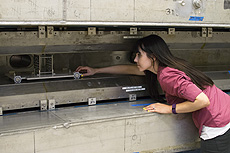Getting teachers back on TRAC
 |
Kerbie Reader, a high school math teacher, works at the Muon g-2 ring as part of Fermilab's TRAC program. Photo: Ali Sundermier, OC |
Bonnie Weiberg sits down in front of a small monitor in the Proton Assembly Building at Fermilab. Her job is to test the signal strength of the liquid-argon purification monitors for the proposed DUNE experiment. But Weiberg isn't your average particle physicist. In fact she isn't a physicist at all: She's a physics and chemistry teacher at Niles North High School in Skokie, Illinois.
Weiberg is here this summer as part of the Fermilab TRAC program, which is funded by the Particle Physics Division. Harry Cheung, an associate head for the CMS Department who has been head of the TRAC program since 2010, said that this year, seven teachers were selected from a pool of 33 applicants to be matched with a mentor and work on cutting-edge physics.
The TRAC program gives middle school and high school teachers of science, math, computer science and engineering an opportunity to come to Fermilab, work with a scientist or an engineer for eight weeks, and experience what Fermilab research is like.
This summer the teachers, most of whom are from Illinois, are working on projects such as building and testing photodetectors, reconstructing the Muon g-2 ring and controlling high-voltage supplies for the MINERvA neutrino experiment.
"Many of us haven't done any research since college," Weiberg said. "It's nice to come back and be in a research environment to see what's happening on the cutting edge."
Kerbie Reader, a high school math teacher at Forest Ridge School of the Sacred Heart in Bellevue, Washington, said that TRAC is the only program she could find in the country that enables teachers to participate in this sort of research. She appreciates the opportunity to remember what it's like to be a student and to gain experience that will help her relate to her own students.
"We're seeing the same material year after year. We forget what it's like to be the person who's learning," Reader said. "Instead of saying it's been 10 or 20 years since I felt that way, I can say, 'I felt that way last summer. I get that it's hard, and this is how we're going to work through it.'"
Weiberg and Reader agreed that the most valuable aspect of this program is being able to gain real-life experiences that they can bring back to their schools and share with their students. Weiberg is even working on a unit about particle physics to incorporate into her curriculum.
"It'll help us engage our students more," Weiberg said. "The more real-world things you can bring into your classroom, the better."
Reader added that the TRAC program gives her a chance to participate in difficult research: to be challenged and learn the value of getting things wrong.
"I want to teach my students not to give up on something because they think it's hard, to be able to tell them: making a mistake is not the problem," Reader said. "Everybody that works on all these fantastic things have been making mistakes their entire lives. The day you figure out what your mistakes are, that's the day you celebrate."
—Ali Sundermier
|